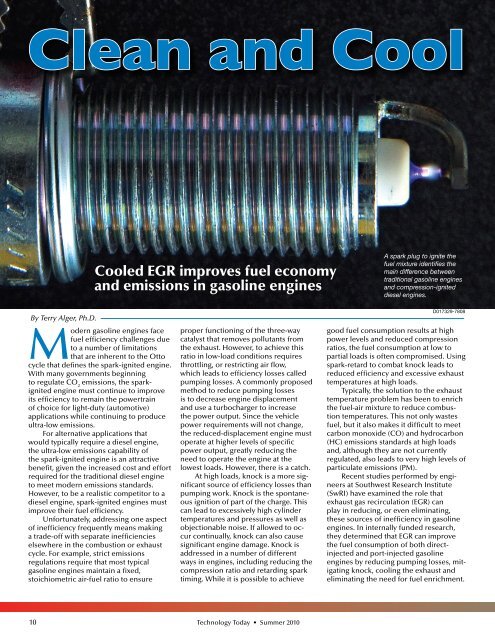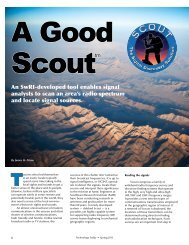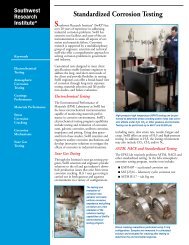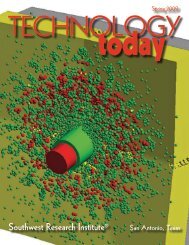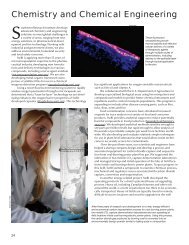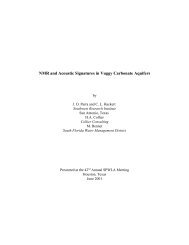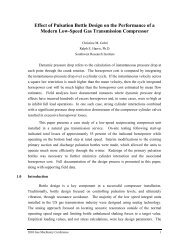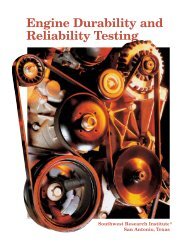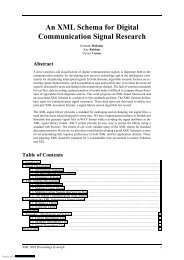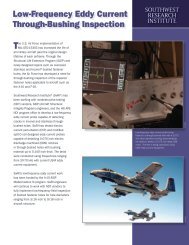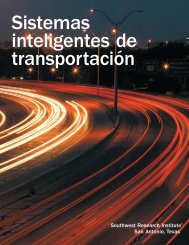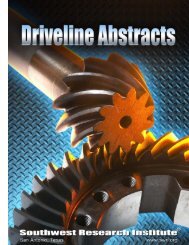Clean and Cool - Southwest Research Institute
Clean and Cool - Southwest Research Institute
Clean and Cool - Southwest Research Institute
You also want an ePaper? Increase the reach of your titles
YUMPU automatically turns print PDFs into web optimized ePapers that Google loves.
<strong>Clean</strong> <strong>and</strong> <strong>Cool</strong><br />
<strong>Cool</strong>ed EGR improves fuel economy<br />
<strong>and</strong> emissions in gasoline engines<br />
A spark plug to ignite the<br />
fuel mixture identifies the<br />
main difference between<br />
traditional gasoline engines<br />
<strong>and</strong> compression-ignited<br />
diesel engines.<br />
By Terry Alger, Ph.D.<br />
Modern gasoline engines face<br />
fuel efficiency challenges due<br />
to a number of limitations<br />
that are inherent to the Otto<br />
cycle that defines the spark-ignited engine.<br />
With many governments beginning<br />
to regulate CO 2<br />
emissions, the sparkignited<br />
engine must continue to improve<br />
its efficiency to remain the powertrain<br />
of choice for light-duty (automotive)<br />
applications while continuing to produce<br />
ultra-low emissions.<br />
For alternative applications that<br />
would typically require a diesel engine,<br />
the ultra-low emissions capability of<br />
the spark-ignited engine is an attractive<br />
benefit, given the increased cost <strong>and</strong> effort<br />
required for the traditional diesel engine<br />
to meet modern emissions st<strong>and</strong>ards.<br />
However, to be a realistic competitor to a<br />
diesel engine, spark-ignited engines must<br />
improve their fuel efficiency.<br />
Unfortunately, addressing one aspect<br />
of inefficiency frequently means making<br />
a trade-off with separate inefficiencies<br />
elsewhere in the combustion or exhaust<br />
cycle. For example, strict emissions<br />
regulations require that most typical<br />
gasoline engines maintain a fixed,<br />
stoichiometric air-fuel ratio to ensure<br />
proper functioning of the three-way<br />
catalyst that removes pollutants from<br />
the exhaust. However, to achieve this<br />
ratio in low-load conditions requires<br />
throttling, or restricting air flow,<br />
which leads to efficiency losses called<br />
pumping losses. A commonly proposed<br />
method to reduce pumping losses<br />
is to decrease engine displacement<br />
<strong>and</strong> use a turbocharger to increase<br />
the power output. Since the vehicle<br />
power requirements will not change,<br />
the reduced-displacement engine must<br />
operate at higher levels of specific<br />
power output, greatly reducing the<br />
need to operate the engine at the<br />
lowest loads. However, there is a catch.<br />
At high loads, knock is a more significant<br />
source of efficiency losses than<br />
pumping work. Knock is the spontaneous<br />
ignition of part of the charge. This<br />
can lead to excessively high cylinder<br />
temperatures <strong>and</strong> pressures as well as<br />
objectionable noise. If allowed to occur<br />
continually, knock can also cause<br />
significant engine damage. Knock is<br />
addressed in a number of different<br />
ways in engines, including reducing the<br />
compression ratio <strong>and</strong> retarding spark<br />
timing. While it is possible to achieve<br />
D017329-7808<br />
good fuel consumption results at high<br />
power levels <strong>and</strong> reduced compression<br />
ratios, the fuel consumption at low to<br />
partial loads is often compromised. Using<br />
spark-retard to combat knock leads to<br />
reduced efficiency <strong>and</strong> excessive exhaust<br />
temperatures at high loads.<br />
Typically, the solution to the exhaust<br />
temperature problem has been to enrich<br />
the fuel-air mixture to reduce combustion<br />
temperatures. This not only wastes<br />
fuel, but it also makes it difficult to meet<br />
carbon monoxide (CO) <strong>and</strong> hydrocarbon<br />
(HC) emissions st<strong>and</strong>ards at high loads<br />
<strong>and</strong>, although they are not currently<br />
regulated, also leads to very high levels of<br />
particulate emissions (PM).<br />
Recent studies performed by engineers<br />
at <strong>Southwest</strong> <strong>Research</strong> <strong>Institute</strong><br />
(SwRI) have examined the role that<br />
exhaust gas recirculation (EGR) can<br />
play in reducing, or even eliminating,<br />
these sources of inefficiency in gasoline<br />
engines. In internally funded research,<br />
they determined that EGR can improve<br />
the fuel consumption of both directinjected<br />
<strong>and</strong> port-injected gasoline<br />
engines by reducing pumping losses, mitigating<br />
knock, cooling the exhaust <strong>and</strong><br />
eliminating the need for fuel enrichment.<br />
10<br />
Technology Today • Summer 2010
D017542-6878<br />
Dr. Terry Alger is manager of the Advanced Combustion <strong>and</strong><br />
Emissions Section of the Engine, Emissions <strong>and</strong> Vehicle<br />
<strong>Research</strong> Division. A mechanical engineer with an emphasis<br />
on thermal <strong>and</strong> fluid systems, he specializes in combustion<br />
systems, combustion research <strong>and</strong> optical diagnostics. He has<br />
authored more than 20 technical papers <strong>and</strong> reports <strong>and</strong> is a<br />
past co-recipient of the Society of Automotive Engineers Myers<br />
Award for outst<strong>and</strong>ing student paper.<br />
At low loads, the use of<br />
either internally recirculated<br />
exhaust gas, commonly<br />
referred to as burned<br />
residual, or externally recirculated<br />
exhaust gas (EGR) has been shown<br />
to reduce pumping losses through<br />
the combined effects of displacing<br />
intake air <strong>and</strong> decreasing the charge<br />
density through heating. Meanwhile,<br />
at high loads the addition of cooled<br />
EGR substantially reduces the knock<br />
tendency of the engine, resulting in an<br />
opportunity to advance combustion<br />
phasing <strong>and</strong> improve the combustion<br />
cycle efficiency.<br />
In addition, combining advanced<br />
combustion phasing with increased<br />
heat capacity of the fuel-air mix results<br />
in a substantial decrease in exhaust<br />
temperatures. This eliminates the need<br />
for a rich mixture at even the highest<br />
power levels. Finally, EGR has been<br />
shown to reduce emissions of carbon<br />
monoxide (CO) <strong>and</strong> particulate matter<br />
(PM) as well as oxides of nitrogen (NOx).<br />
Engine study<br />
The SwRI team selected a 2.4L portinjected<br />
engine <strong>and</strong> 1.6L direct-injected<br />
engine for the study. Each was run with<br />
high levels of both cooled <strong>and</strong> uncooled<br />
EGR. Both engines were turbocharged.<br />
The purpose of selecting two types of<br />
fuel injection<br />
systems was<br />
to determine<br />
whether the<br />
benefits of EGR<br />
can be realized<br />
across engine<br />
platforms.<br />
A prototype<br />
EGR system was<br />
installed on each<br />
engine, consisting of an EGR cooler <strong>and</strong><br />
valve installed in such a manner as to route<br />
exhaust gas from the turbine outlet to the<br />
compressor inlet. SwRI engineers designed<br />
the system to limit back pressure on the<br />
engine <strong>and</strong> reduce hot internal residual <strong>and</strong><br />
knocking at low speeds <strong>and</strong> high loads.<br />
The ideal efficiency of an Otto-cycle<br />
engine is a function of compression ratio (r c<br />
)<br />
<strong>and</strong> the ratio of specific heats of the working<br />
fluid (g), expressed thus: h ti<br />
= 1 – 1/r c<br />
y-1<br />
For a given engine, the compression<br />
ratio (r c<br />
) is fixed; therefore, the primary<br />
way to affect the fundamental efficiency<br />
is to increase the ratio of specific heats of<br />
the working fluid. For a typical pre-mixed<br />
gasoline engine at wide-open throttle, the<br />
working fluid consists of approximately 8<br />
percent burned residual, 86 percent air <strong>and</strong><br />
6 percent gasoline. At room temperature,<br />
the g of burned gases is about 1.3; air has a g<br />
of 1.4 <strong>and</strong> gasoline has a g of approximately<br />
1. When the EGR level of the engine is<br />
increased, the mass fraction of the gasoline<br />
is reduced; therefore, despite the lower value<br />
of g for burned gases compared to air, the<br />
overall ratio of specific heats for the mixture<br />
increases. When EGR was added, although<br />
the difference in specific heat ratio appeared<br />
small it was enough to result in more than a<br />
1 percentage point increase in thermal efficiency<br />
with 20 percent additional EGR.<br />
In addition, adding EGR increased the<br />
specific heat capacity <strong>and</strong> thermal mass of<br />
the fuel-air mix, resulting in lower peak<br />
temperatures during combustion.<br />
Lower combustion temperatures<br />
result in a reduction of heat transfer<br />
losses, as the majority of the heat<br />
transfer losses occur during <strong>and</strong> after<br />
the combustion event, when the<br />
surface area to volume ratio of the<br />
engine was maximized.<br />
Another significant source of losses<br />
in an internal combustion engine<br />
is heat transfer to the engine coolant.<br />
By reducing the peak temperatures,<br />
the use of high levels of EGR reduced<br />
the amount of heat transfer to the<br />
engine coolant, improving efficiency.<br />
For example, at the 1500 rpm / 191 N-m<br />
brake torque (30 kW brake power) condition,<br />
the addition of EGR reduced the<br />
engine’s heat transfer to the coolant by<br />
approximately 6 kW, or 20 percent of<br />
the total engine power output.<br />
Given the industry trend of downsizing<br />
<strong>and</strong> boosting, which leads to<br />
operation at high specific power levels,<br />
the most significant effect of EGR<br />
addition is on combustion phasing.<br />
Adding EGR slowed reaction rates,<br />
leading to longer burn rates <strong>and</strong> the<br />
suppression of knock, yielding more<br />
advanced spark timing <strong>and</strong> allowing<br />
more optimized combustion phasing.<br />
In addition, the improvement in<br />
combustion phasing with EGR was<br />
not limited to port-injection engines.<br />
Despite the recognized improvement<br />
in the knock limit from directinjection<br />
engines, EGR can also have<br />
a considerable impact on combustion<br />
phasing in that engine. The improvement<br />
in combustion phasing can<br />
result in as much as a 10-15 percent<br />
improvement in fuel consumption at<br />
a given engine speed <strong>and</strong> torque <strong>and</strong>,<br />
for future engines, enables the use of<br />
higher compression ratios at elevated<br />
torque levels.<br />
Technology Today • Summer 2010 11
D017542-6922<br />
SwRI’s proprietary Dual Coil Offset (DCO) ignition system significantly extends<br />
the EGR tolerance of gasoline engines, enabling higher efficiency operation.<br />
D017542-7002<br />
Fuel efficiency<br />
Another significant source of fuel consumption<br />
improvement at high load was<br />
the elimination of the enrichment region.<br />
The primary reason for the presence of the<br />
enrichment region is to keep exhaust manifold<br />
temperatures below the supplier’s prescribed<br />
limit of 900 degrees C, with excess<br />
fuel being the primary source of cooling.<br />
The result of the enrichment requirement is<br />
an increase in the relative fuel-air ratio along<br />
the wide-open throttle curve. Depending<br />
on the specific power level <strong>and</strong> the engine<br />
design, the engine could run as much as<br />
50 percent excess fuel or more to keep the<br />
temperature below the limit. This, in turn,<br />
leads to fuel consumption values in excess<br />
of 300 g/kWh.<br />
Adding<br />
EGR can reduce<br />
the enrichment<br />
requirement<br />
through two<br />
mechanisms.<br />
The first is<br />
through increasing<br />
the specific<br />
heat <strong>and</strong> thermal<br />
mass of the<br />
mixture, which<br />
results in lower<br />
EGR coolers<br />
are a key<br />
component<br />
to enabling<br />
high efficiency.<br />
Exhaust<br />
gases flow<br />
through the<br />
cooler, which<br />
is bathed in<br />
engine coolant.<br />
peak combustion temperatures <strong>and</strong><br />
a general decrease in cycle temperatures.<br />
The second is through allowing<br />
more spark advance <strong>and</strong> moving the<br />
location of peak temperature earlier<br />
in the cycle. This increases the expansion<br />
ratio of the gas <strong>and</strong> results in<br />
lower temperatures at blowdown <strong>and</strong><br />
during the exhaust event.<br />
The end result of this mechanism<br />
was a reduction in exhaust gas<br />
temperature of about 5 degrees C<br />
per 1 percent of EGR on average. In<br />
general, at least 10 percent of EGR was<br />
required to eliminate the enrichment<br />
requirement altogether <strong>and</strong> still maintain<br />
the exhaust temperature below<br />
the 900-degree limit.<br />
Pumping loss reduction<br />
The addition of EGR also served<br />
to reduce pumping losses in the<br />
engine. At part load conditions, when<br />
the engine intake manifold pressure<br />
was less than the atmospheric pressure,<br />
adding EGR (either internal or<br />
external) resulted in a small reduction<br />
of pumping losses, with a corresponding<br />
slight improvement of fuel<br />
consumption. However, the point of<br />
lowest pumping loss is not the point<br />
of least fuel consumption. This is because<br />
the fuel burn rate <strong>and</strong> engine stability both<br />
degrade with the addition of diluent. At<br />
high loads, the reduction in the burn rate<br />
was desirable, because the same mechanism<br />
reduces the likelihood of knock, but<br />
at low loads the engine rapidly became<br />
unstable. At very low loads, those losses<br />
can be up to 30 percent of the engine’s<br />
brake power. A main accomplishment of<br />
SwRI’s HEDGE I consortium was developing<br />
an ignition system that allows the<br />
engine to run at high diluent levels <strong>and</strong><br />
still remain stable. SwRI’s DCO system<br />
has shown the ability to improve EGR tolerance<br />
in a gasoline engine by a factor of<br />
4 at low load conditions. However,<br />
it appears as if the pumping loss<br />
reduction is the least significant<br />
benefit from EGR at higher loads.<br />
The results presented above<br />
for efficiency illustrate the potential<br />
benefits of using a high EGR<br />
scheme to improve fuel consumption.<br />
However, they do not take<br />
into account improvements that<br />
are allowed to the engine hardware,<br />
primarily through the reduction<br />
of knock. In the optimal situation,<br />
knock reduction due to EGR can<br />
allow engine designers to either<br />
increase the level of downsizing<br />
This schematic of an engine fitted with<br />
cooled exhaust gas recirculation (EGR)<br />
illustrates how the hottest exhaust<br />
gases, shown in red <strong>and</strong> orange,<br />
are cooled (yellow) before being<br />
recirculated amid the cooler (blue)<br />
ambient air in the intake.<br />
D017580<br />
12<br />
Technology Today • Summer 2010
or down-speeding, or increase the<br />
compression ratio. This opportunity,<br />
if properly taken advantage of, can<br />
lead to even larger improvements in<br />
vehicle fuel efficiency.<br />
D017581-9253<br />
Emissions reductions<br />
At high levels of EGR, the reduction<br />
in peak combustion temperatures<br />
resulted in a significant reduction<br />
in two of the three primary<br />
pollutants. Since the 1970s, EGR has<br />
been used to reduce NOx. In fact,<br />
NOx can be reduced by up to 80 percent<br />
with the addition of more than<br />
20 percent EGR.<br />
While the level of NOx reduction<br />
was high, it was an expected<br />
result of adding EGR. What is more<br />
interesting is the level of reduction<br />
in CO that occurred as well. When<br />
the engine is stable, CO emissions<br />
are primarily influenced by combustion<br />
temperatures <strong>and</strong> pressures, as<br />
the dissociation of CO 2<br />
into CO <strong>and</strong><br />
O 2<br />
is highly temperature- <strong>and</strong> pressuredependent<br />
(similar to the NOx reactions).<br />
The addition of EGR, <strong>and</strong> the corresponding<br />
reduction in combustion temperatures<br />
<strong>and</strong> increase in pressure, can suppress<br />
this dissociation reaction. The SwRI<br />
team achieved a 50 percent reduction in<br />
CO emissions from the engines involved<br />
in its EGR research. The only pollutant<br />
that appeared to be adversely affected by<br />
EGR addition was unburned hydrocarbons<br />
(HC), whose emissions increased slightly<br />
with the addition of cooled EGR. The primary<br />
mechanisms for the increase were<br />
increased quench distances <strong>and</strong> partial<br />
combustion, as well as cooled post-flame<br />
temperatures. The combination of reduced<br />
combustion temperatures <strong>and</strong><br />
engine instability as the EGR limit was approached<br />
led to the increase in HC emissions<br />
in the port-injected engine near 30<br />
percent EGR. However, it should be noted<br />
that the overall level of HC emissions was<br />
still within the range controllable by a<br />
three-way catalyst.<br />
Overall, the results showed that<br />
engine-out NOx was approximately four<br />
times lower than a typical engine <strong>and</strong> CO<br />
emissions were cut in half. HC emissions<br />
increased slightly, but still within reason<br />
for an oxidation catalyst or three-way<br />
catalyst.<br />
In addition to reducing two of the<br />
three primary pollutants from gasoline<br />
engines regulated by the EPA, the addition<br />
of EGR also has been shown to reduce the<br />
emission of particulates (PM). The reduction<br />
in PM emissions has been attributed<br />
to reduced combustion temperature<br />
Members of the HEDGE consortium research team within SwRI’s Engine, Emissions <strong>and</strong> Vehicle<br />
<strong>Research</strong> Division, left to right: Dr. Charles E. Roberts Jr., <strong>Institute</strong> engineer; Dr. Terry Alger, manager;<br />
Patricia Gamboa, administrative assistant; Dr. Michael Joo, senior research engineer; Jess Gingrich,<br />
senior research engineer; Dr. Zainal Abidin, research engineer; Barrett Mangold, research technologist;<br />
Rafael Gukelberger, intern; Steven Almaraz, research assistant; <strong>and</strong> Craig Gibson, principal technician.<br />
suppressing the PM formation rate. In<br />
addition, at high loads, the reduction in<br />
enrichment leads to a significant reduction<br />
in PM emissions as the presence of<br />
a rich mixture (excess fuel) leads to very<br />
high PM emissions, even in pre-mixed<br />
gasoline engines. SwRI has initiated an<br />
internally funded project to investigate<br />
the effect of our cooled EGR technology<br />
on the PM emissions from a directinjection<br />
engine, where the method of<br />
injection has been shown to lead to high<br />
PM emissions.<br />
Performance improvements<br />
The strategy for engine operation<br />
was to run maximum internal EGR at low<br />
loads, transitioning to cooled EGR at high<br />
loads. The level of cooled EGR varied as a<br />
function of speed <strong>and</strong> load, with the EGR<br />
level declining if one desired to increase<br />
torque. At high loads the turbocharging<br />
requirements of the engine led to a<br />
requirement to either reduce EGR flow<br />
or accept lower torque levels.<br />
Fuel consumption decreased in the<br />
range from 5 percent to 30 percent compared<br />
to a typical port-injected engine,<br />
depending on the speed load condition<br />
examined. For example, the results at light<br />
load conditions yielded ~335 g/kWh fuel<br />
consumption, which was approximately<br />
8 percent lower than typical engines.<br />
At higher loads, where typical engines<br />
may be knock-limited, the improvement<br />
was better – on the order of 10-15 percent<br />
– due to the reduction in knock <strong>and</strong><br />
improvement in combustion phasing.<br />
At high power conditions the improvement<br />
was better still, with the elimination<br />
of enrichment combining with the reduction<br />
in knock to produce up to a 30 percent<br />
reduction in fuel consumption.<br />
Conclusion<br />
The results showed that, by adding<br />
cooled EGR systems, it is possible to<br />
decrease fuel consumption by 5 percent to<br />
30 percent, with the largest improvement<br />
occurring in the typical enrichment<br />
region. The results also showed that EGR<br />
can reduce knock, resulting in improved<br />
combustion phasing with a corresponding<br />
decrease in fuel consumption <strong>and</strong> exhaust<br />
temperatures. Adding EGR led to lower<br />
peak cylinder temperatures <strong>and</strong> engine<br />
heat rejection, resulting in improved<br />
thermodynamic efficiency <strong>and</strong> a reduced<br />
heat rejection requirement from the<br />
engine block. Finally, the high levels<br />
of EGR used in the study reduced CO<br />
emissions by 30 percent <strong>and</strong> NOx by up to<br />
80 percent. The results indicate that adding<br />
high levels of EGR to gasoline engines is<br />
a very cost-effective way to reduce fuel<br />
consumption as well as emissions.<br />
The use of cooled EGR in gasoline<br />
engines has been investigated as part of<br />
the High-Efficiency, Dilute Gasoline Engine<br />
(HEDGE) consortium at SwRI since 2005.<br />
A number of auto manufacturers who<br />
participated in the HEDGE consortium<br />
have adopted this technology for new<br />
engine designs.v<br />
Questions about this story?<br />
Contact Alger at 210-522-5505 or<br />
terry.alger@swri.org.<br />
Technology Today • Summer 2010 13


